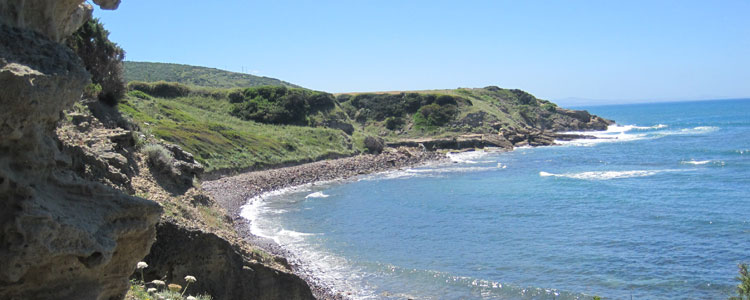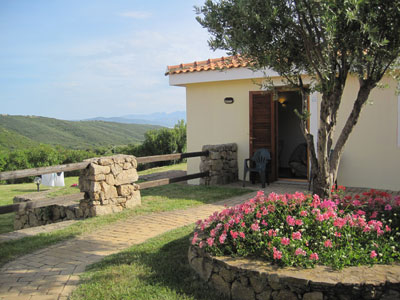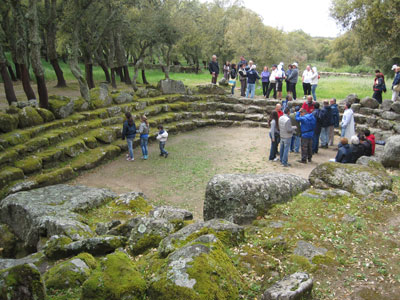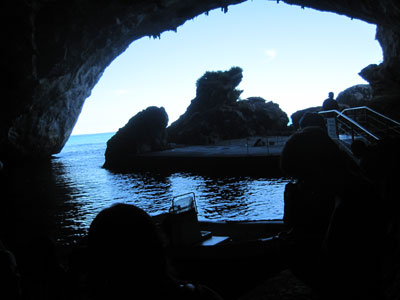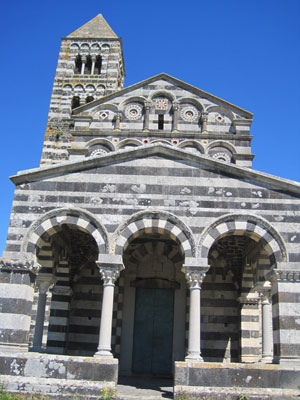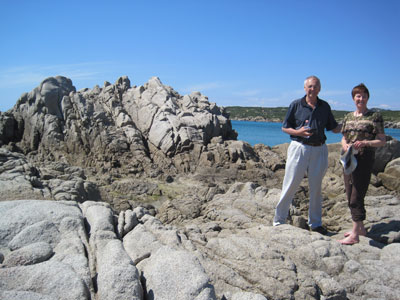Off-season in Sardinia
by Carol Probst; Bethel Park, PA
My husband, Lynn, and I are timeshare owners and frequently peruse the website of Interval International (Miami, FL; fax 305/667-5321) seeking a suitable swap. When La Fenice Resort (phone +078958012, [website in Italian only]) in Sardinia, Italy, became available for a week in mid May ’11, we pounced, ultimately making it the centerpiece for a three-week trip to southern Italy.
A rocky start
Fast-forward to May. After spending a week in Italy visiting Rome and Pompeii, which we found exhilarating, we were nonetheless ready for a change of pace: fewer crowds, with more wonders of nature rather than of man. Sardinia, we hoped, would fit the bill.
I had prebooked round-trip passage with Moby Lines (Wiesbaden, Germany; fax +49 [0] 611 140 2244) on a huge ferry capable of carrying over 2,000 passengers and 700 vehicles. Departing at 3 p.m. from the port of Civitavecchia, near Rome, the ferry was scheduled to arrive in Olbia, Sardinia, four hours later.
Less than half-filled, the vessel had plenty of seats available, and our padded bench even allowed me to stretch out and nap. Naively anticipating a scenic voyage, I was disappointed to discover only a monotonous stretch of ocean, plus strong headwinds discouraged any outside viewing. At least the seas were calm and the cafeteria-style dining room provided our evening meal.
Unfortunately, the ferry chugged into Olbia 45 minutes late — a troublesome development, as we wanted to get to the airport to pick up our rental car before dark. The next several hours were, without doubt, the worst experience of our entire trip.
The sun was setting as I made several wrong turns trying to exit the airport. To add to our troubles, the directions sent by Interval International for getting to La Fenice were totally inadequate and, thanks to ongoing construction, erroneous. The few people we encountered didn’t speak English and had never heard of our resort, and we had only spotty cell phone coverage.
After over two hours lost on dark, deserted roads, I couldn’t pretend to be brave any longer. We were almost resigned to having to sleep in the car, but as we pulled into a lit (but closed) service station we noticed that our cell phone was finally working.
I phoned the resort in tears and was told a representative would come to get us. Seldom have I been happier to see anyone! It turned out we were only 10 minutes away, but following our rescuers to the resort involved a number of confusing turns in the dark that we would never have found on our own.
Getting settled
Morning found our spirits revived, especially after we talked to some of our neighbors and learned that they had also gotten hopelessly confused trying to find the resort. (And these people were Italian!) Still, we had to admit that the place was pretty — an enclave of pink bungalows ablaze with colorful plantings and framed by the scenic hills of Sardinia. Other amenities included a large pool, tennis courts and a restaurant.
The downside? Its location was remote, nowhere near any stores or supplies. Intending to eat most meals en suite, we needed to screw up our courage to venture out again. A woman at the front desk gave us a map and directions into the nearby city of Olbia, but my confidence plummeted when she confessed to getting lost three times in the last week.
En route to Olbia, we somehow managed to go astray again. We eventually spotted the service station from the previous night, but this time it was open. The young attendant, who spoke only Italian, managed through gestures and a hand-drawn map to get us back on the right road to town.
Once there, a kind Sardinian helped Lynn negotiate the ATM and, currency in hand, we tackled the grocery store.
On our return trip we got lost once more, so we, again, stopped at the service station to phone the resort. Alas, nobody at the front desk at that time spoke much English. To the rescue came the sweet gas-station attendant, who got on our cell phone, chattered away in Italian and then drew yet another set of directions for us. (His handmade maps permanently resolved any difficulties getting around in Olbia.)
The weather was gorgeous, so after lunch we decided to locate nearby Pittulongu Beach, recommended by our guidebook. Road signs led us down a narrow, deeply pitted dirt “road” to the beach. After checking to make sure the car’s undercarriage was still intact, we took off to explore.
This lovely crescent of sandy beach stretched for at least half a mile with few people in sight. A couple of hardy souls frolicked in the waves, but we found the water too cold.
Purchasing some ice cream sandwiches from a seaside hut, Lynn and I sat in the warm sand and enjoyed the beautiful scenery, our first real “relax” in almost two days.
Follow the leader
That evening we were approached by one of the staff to participate in a resort-sponsored visit to Complesso Nuragico Su Romanzesu. (Sardinia is famous for its numerous prehistoric stone edifices known as nuraghi.) As an added enticement, a five-course lunch (€30, or $42, per person, including wine) would be provided. It sounded good, so Lynn and I signed up.
At 9:30 the next morning we joined almost 40 other people who were waiting in the parking lot and were stunned to learn that everyone would be traveling via caravan. Only half of the folks had transportation, so the organizers assigned each of us with cars an additional two passengers. Four young staff members then jumped into a vehicle and took off, expecting the other 10 cars to follow. Fifteen minutes later, our fearless leaders had a flat tire.
Eventually, we were on our way again, ultimately entering the interior of Sardinia. The landscape of jagged granite peaks and deep ravines was hauntingly beautiful. This was wild country, indeed.
Unfortunately, our leaders seemed confused. They stopped no less than four times for directions, and during one U-turn they lost half of the caravan in the village of Bitti. Only realizing this miles later, they told those of us in the five remaining cars to wait along the highway while they went back to locate the others. Sheer madness!
After 30 minutes, one member of the caravan (who had located the site using a GPS) took off. Lynn and I were right behind them.
After so much time in the car, it was disheartening to learn that the site had no facilities. Desperate, most of us used the woods, but when the last half of the caravan finally arrived, six women insisted on toilets. They had to be driven 13 kilometers back to town for a bathroom while the rest of us waited.
Meanwhile, the weather had deteriorated, the cold winds and sporadic drizzle adding to our misery. I remember thinking, “This place had better be worth it.” Thankfully, it was.
The Complesso Nuragico Su Romanzesu is an important archaeological site spread out over 17 acres and featuring a wide variety of moss-covered stone ruins dating from 1700 BC. There were circular huts, dwellings for worship and, most impressive, a sacred well temple connected to a semicircular amphitheater. All this was juxtaposed against a lovely forest of cork trees and wildflowers.
The park ranger, himself, led our tour; although he spoke only Italian, one of the resort staff translated into English.
Things were looking up. The skies began to clear, and this was a place unlike anything we had ever seen.
More missteps
Leaving at 3 o’clock, we were late getting to the Agriturismo Romanzesu for our scheduled lunch. However, when we arrived we found a long table set up with antipasto and wine. Our four leaders promptly ensconced themselves and began to dig in. Unfortunately, it soon became obvious that there was an insufficient number of seats and four unlucky people had no place to sit. They waited, but when no more plates were set out, they left in a huff.
Finally, one man stood up and exclaimed, “This is outrageous! How can you, the staff, sit here while four of your guests are out in the parking lot with no food?”
Looking only marginally abashed, one of the offenders went outside only to return and announce, “They refuse to eat now. What can we do?” Then, with a shrug, she helped herself to more wine.
Eventually, several guests took some plates of food to the “outcasts.”
The meal was delicious, but several hours later the Italian half of our group (well into the wine by now) showed no signs of leaving. When I cornered one of the resort staff to ask about a departure time, I was told, “We can’t go until everyone is ready.”
Hearing this, a nearby British couple shot back, “Well, we’re leaving now!”
Lynn and I had a quick conference with our two passengers and everyone agreed: nobody had more problems with directions than our “leaders,” and that was when they were sober. Ergo, we should depart immediately.
To make a long story shorter, this intrepid British couple, Cliff and Linda, not only got us back to the resort but turned out to be a lot of fun. We later ended up traveling together for two days.
Independent exploration
We awoke to sunny weather with gentle breezes and temperatures in the mid 70s — a perfect day to explore the northern tip of Sardinia. I mapped out a route that took Lynn and me from Olbia up to Santa Teresa, where we would follow the coast to Porto Torres before looping back via Sassari, giving us maximal exposure to the shoreline famed for its sweeping vistas of sea, beaches and cliffs.
Once out of Olbia’s environs, driving wasn’t difficult. The winding, two-lane road skirted villages, and traffic was light. Plus we were starting to get the hang of Sardinian road signs (no highway numbers, only the names of nearby towns).
Past Santa Teresa, a stretch of coastline known as Rena Majore beckoned. Just before reaching the small river of Cantaru, I discovered some tire tracks in the dirt leading to the beach. We followed them in the car as far as possible, then scrambled over some dunes to be confronted with a gorgeous vista.
Nestled between granite bluffs and a peninsula of rolling hills was an arc of pristine beach shared by only a handful of other visitors — a perfect place for our stroll. Waves exploded over rocky outcrops while clumps of pink wildflowers dotted the landscape.
Farther down the road, not far south of Castelsardo, another turnout offered an equally spectacular view, but this time masses of white and yellow wildflowers predominated. These incredibly beautiful spots personified the Sardinia I’d hoped to find.
We stopped for lunch at the small Café Maya before continuing along the coast. Time was slipping away, and we made an ill-fated decision to save 15 miles by cutting through the town of Sassari rather than taking the longer bypass from the north. Big mistake!
We found a larger-than-expected city with no directional signs, and we were lost, again. I must have stopped for directions four times, and, although people tried to help, nobody spoke English. Lynn was in meltdown mode by the time I finally found Route 597 heading toward Olbia.
Serendipitously, while driving east through the commune of Codrongianos we stumbled upon the Basilica della Santissima Trinità di Saccargia. Ancient buildings fascinate Lynn, and this church, consecrated in the year 1116, pulled him out of his funk.
Amazingly, it still serves as a place of worship and features a rare example of Romanesque mural painting from the 11th century in its central apse. The impressive facade, created out of white calcareous stones and darker basalt blocks, stands next to ruins of the original monastic complex. The only visitors, we lingered for almost an hour before returning to the resort.
The grotto
The next day’s destination? Cala Gonone, the port of departure for the beaches of Golfo di Orosei, accessible only by boat or overland trails. Even better, Cliff and Linda would be doing the driving! In particular, we wanted to visit Le Grotte del Bue Marino, a sea cave famous for its fantastic underground formations.
In the off-season, only two boat tours to the grotto (€23 per person) are scheduled, at 11 and 3 o’clock, and we arrived 10 minutes too late for the first one. Oh, well, there are certainly worse places to hang around for four hours than Cala Gonone, a lovely coastal resort set against a mountainous background of gray peaks and overlooking the turquoise waters of Golfo di Orosei. And we were in Italy, where extended dining is the norm.
With plenty of time to check out our options, we eventually selected Hotel Ristorante Bue Marino (Via Vespucci, 8), with its outdoor, shaded seating area overlooking the sea. Thanks to delicious food and good company, the time slipped by quickly.
Almost every seat on the boat to the grotto was filled. Apparently, even in the off-season this spectacular coastline is a popular attraction. Limestone bluffs brandishing caverns and fissures carved by the sea framed slivers of sandy coves. And did I mention the clarity of that turquoise water?
Eventually, the boat pulled into a large sea cave. All passengers disembarked and were separated, by language spoken, into three groups.
A wooden boardwalk led into a cavernous interior, and for the next hour we strolled along illuminated passageways marveling at nature’s chromatic show.
Saltwater infusion was replaced by a shimmery freshwater lake fed by a subterranean river. Watery reflections of the cave’s colorful stalactites and stalagmites added to an illusion of great depth. Incredible! This was a very nice trip, indeed.
Off the main road
The following day, the first stop for the four of us was Olivastri millenari, the site of a 3,800-year-old olive tree (said to be the world’s largest) located near Lago di Liscia, a vast man-made lake. A wooden sign marked the entrance to Olivastri millenari, but where was that tree? Nobody was around to ask.
Stymied, my passengers urged me to leave the tarmac and head up an unpaved, rutted road filled with boulders. Wrong! Going back down was terrifying, inching along in first gear while horrible scraping noises emanated from the car’s undercarriage. (Thank goodness we had purchased extra damage insurance.)
I insisted that we park by the entrance and just walk, and, sure enough, there was a small sheet of plastic-covered paper pointing toward a tiny nature preserve.
The site was home to several huge olive trees, the biggest measuring 20 meters in circumference and 14½ meters high. Wow! Its gnarled branches, larger than most trees, were adorned with tiny white flowers.
Next it was on to the village of Aggius, famed for the Museo Etnografico Olivia Carta Cannas (Via Monti di Lizu, 6), with its emphasis on native textiles and weavings. Also on site was a reconstructed house showcasing traditional ways of life in the area. It was very interesting and, as textiles are one of Linda’s passions, her insights significantly enhanced our appreciation of these intricate crafts.
Even though the museum was a bit difficult to locate, our wanderings provided an opportunity to explore this attractive little town. Narrow streets meandered between old stone buildings, and from each balcony masses of flowering plants cascaded down the walls — definitely off the beaten tourist track.
Only a few miles from Aggius is Valle della Luna with its strange, boulder-strewn landscape, a result of glacial remodeling. Next to a turnout overlooking this unique terrain perched a small café with inviting outdoor seating. (Rats! We could have eaten lunch here instead of in that smoke-filled bar back in town.)
A narrow, paved road led down into the valley, but my plans for hiking were thwarted by wire fences blocking access to the fields, themselves. Still, it would have been a great place to bike.
Of course, we couldn’t return to the resort without showing off our favorite beach at Rena Majore. A half-hour drive north brought us to the spot, but this time the tide was out. The bad news? Seaweed littered the previously pristine sand. The good news? Now we could access a nearby promontory which provided some spectacular vistas.
Lessons learned
Our last full day in Sardinia was spent exploring the northeastern coast. First, we took a quick trip to check out the nearby city of Golfo Aranci, a transport hub worthy (we decided) of only a cursory inspection.
A few miles farther north brought us to the gateway of trendy Costa Smeralda, the town of Porto Rotondo, where police gave us directions to one of the local beaches. As it was early in the season, there was no charge for admission or parking (which in summer must be substantial, if my four-euro can of Pepsi there was any indication of costs).
Back in the car, we decided to continue along the road and check out some of the oceanfront estates. Although gated, they still afforded glimpses of the enormous wealth of this area.
Returning through Porto Rotondo, we stopped for lunch at Pasticceria I Valentini (Via Monte Ladu, 85), a roadside restaurant approximately two kilometers outside of Porto Rotondo. It was the best meal (€18 each) we had in Sardinia.
Finally comfortable navigating Sardinia’s roads, I was sad to think of leaving the following day.
Recounting our Sardinian experiences, we concluded that, for sheer scenic beauty, this island (and we’ve seen plenty) ranks right at the top.
Although we saw only one American the whole time, it is the destination of choice for Italians, particularly during the summer months. To avoid crowds, we recommend visiting in the spring or fall. Mid May was perfect!
A car is essential for travel there, as public transportation is very limited. Most travelers will probably be much less timid about driving than we were, but a GPS would have been very helpful.
In the off-season, the ferry’s scheduled arrival at Olbia is pretty late in the day. I’d recommend either flying in or, if taking the ferry, arranging for shuttle service to the resort, returning in the morning to pick up your rental car.
As resorts go, La Fenice had some issues. Since it was a timeshare swap through Interval International, our costs were negligible ($175), but unless you planned to spend the entire week on site (and many visitors did during our stay), the place is not convenient to anything. Shuttle service is provided for a fee (€12 per person), and several excursions can be arranged (that one convoy did it for us, however).
Most of the staff speak English, and all were friendly. The apartment unit, itself, was spacious and clean, but the kitchen had no microwave or oven and only two burners for cooking. Tap water was not potable.
Looking back, one week in Sardinia was not enough, and we would return to the island in a heartbeat.

